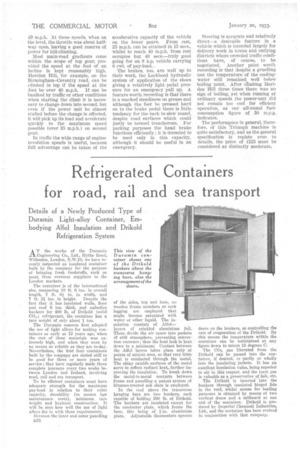Refrigerated Containers
Page 52

If you've noticed an error in this article please click here to report it so we can fix it.
for road, rail and sea transport AT the works of the Duramin Engineering Co., Ltd. Hythe Road, Willesden, London, NAVA, we have recently inspected an insulated container built by the company for the purpose of bringing fresh foodstuffs, such as meat, from overseas suppliers to the London markets.
The container is of the international size, measuring 10 ft. 6 ins, in overall length, 7 ft. Ott in_ in width, and
7 ft. 2i ins, in height. Despite the fact that it has insulated walls, floor and roof 6 ins, thick, and embodies bunkers for 400 lb. of Drikold (solid C0-2) refrigerant, the container has a tare weight of only about 1 ton.
The Duramin concern first adopted the use of light alloys for making containers as early as 12 years ago, when the cost of these materials was extremely high, and when they were by no means so reliable as they are to-day. Nevertheless, the first four containers built by the company are stated still to be good for three or more years of service; they have regularly made three complete journeys every two weeks between London and Ireland, involving road, rail and sea transport. •
To be efficient containers must have adequate strength for the maximum pay-lead in relation to their cubic capacity, durability (to ensure law maintenance costs), minimum tare weight and hygienic construction. It will be seen how well the use of light alloys fits in with these requirements.
Between the inner and outer panelling B38
of the sides, top and base, no wooden frame members or cork lagging are employed that might become saturated with water or other liquid. The insulation consists of Alfollayers of crinkled aluminium foil. These divide the air space into pockets of still atmosphere, preventing convection currents ; thus the heat leak is kept down to a minimum: Contact between the Alfol layers takes place only at points of minute area, so that very little heat is conducted through the metal. The shiny outside surfaces of the metal serve to reflect radiant heat,. furtherimproving the insulation. To break down the metal-to-metal contacts between frame and panelling a patent system of bitumen-treated ash slats is employed.
In the roof above the transverse hanging bars are two bunkers, each capable of holding 200 lb. of Drikold. The bunkers are insulated except for the conductor plate, which forms the base, this being of i-in, aluminium plate. Adjustable thermostats operate
doors on the bunkers, so controlling the rate of evaporation of the Drikold. By this means the temperature within the container can be maintained at any figure down to minus 15 degrees C.
The CO n gas liberated from the Drikold can be passed into the container, if desired, or partly or wholly into the insulating jackets. It has an excellent insulation value, being superior to air in this respect, and the inert gas is valuable as a preservative of fish, etc. The Drikold is inserted into the hunkers through insulated hinged lids in the roof, whilst access for loading purposes is obtained by means of two vertical doors and a tailboard at one end of the container. Drikold is produced by Imperial Chemical Industries, Ltd., and the container has been evolved in conjunction with that company.




























































































